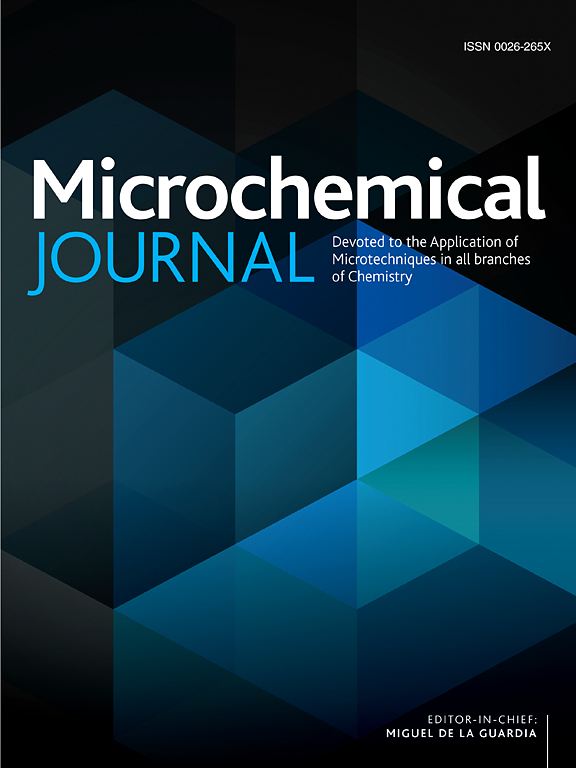Utility of cauliflower waste/garlic biomass admixture for green synthesis of multi-doped CQDs as a fluorescent optosensor for Fe3+ in different matrices
IF 4.9
2区 化学
Q1 CHEMISTRY, ANALYTICAL
引用次数: 0
Abstract
A simple method for the synthesis of multi-doped carbon quantum dots (CQDs) has been developed via a fast, affordable, and green pathway from natural, nontoxic, and inexpensive substrates as garlic and cauliflower leaves and stalk as a plant by-product by the aid of microwave. The synthesized fluorescent CQDs have excellent quantum yield of 42 % at λex/λem of 330/411 nm with superb stability. The CQDs were fully described using energy-dispersive X-ray, X-ray diffraction, transmission electron microscopy, Fourier transform infrared spectroscopy, Zeta potential, UV–visible spectroscopy, and fluorescence spectroscopy which demonstrate that CQDs are doped with multiple elements including sulfur, nitrogen, phosphorus, potassium, sodium, and calcium. It has been noted that Fe3+ specifically quenches the CQDs’ fluorescence, unlike other heavy metals. Based on this phenomenon, the produced CQDs revealed outstanding results as a fluorescent optosensor for iron determination over the concentration range of 10.0–400.0 μM with a limit of detection of 3.29 μM. The proposed method is effective for determining Fe3+ in pharmaceutical dosage form with mean % recovery of 98.73 ± 0.75 %. Additionally, the synthesized CQDs also showed a significant promising potential in environmental applications for detection of Fe3+ in tap, irrigation, and river water with mean % recovery of 99.45 ± 1.71, 100.57 ± 1.32, and 101.49 ± 2.44 %, respectively. Several greenness measures and software approved the greenness of the designed optosensor. This approach proved that green synthesis could furnish CQDs from natural low-cost substrates with distinct outstanding characteristics that are suited for certain uses without consuming hazard materials unlike traditional methods.

求助全文
约1分钟内获得全文
求助全文
来源期刊

Microchemical Journal
化学-分析化学
CiteScore
8.70
自引率
8.30%
发文量
1131
审稿时长
1.9 months
期刊介绍:
The Microchemical Journal is a peer reviewed journal devoted to all aspects and phases of analytical chemistry and chemical analysis. The Microchemical Journal publishes articles which are at the forefront of modern analytical chemistry and cover innovations in the techniques to the finest possible limits. This includes fundamental aspects, instrumentation, new developments, innovative and novel methods and applications including environmental and clinical field.
Traditional classical analytical methods such as spectrophotometry and titrimetry as well as established instrumentation methods such as flame and graphite furnace atomic absorption spectrometry, gas chromatography, and modified glassy or carbon electrode electrochemical methods will be considered, provided they show significant improvements and novelty compared to the established methods.
 求助内容:
求助内容: 应助结果提醒方式:
应助结果提醒方式:


